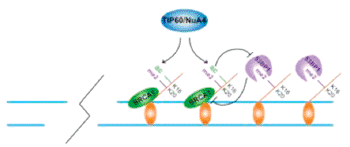Histone Acetylation Determines Cellular DNA-Repair Strategy
By LabMedica International staff writers
Posted on 19 Feb 2013
A team of cancer biologists have identified the molecular signal that determines which repair mechanism will be used by a cell to repair broken double-strand DNA.Posted on 19 Feb 2013
Double-strand DNA breaks (DSBs) are a regular occurrence in dividing cells or may result from damage caused by ionizing radiation, reactive oxygen species (ROS), or exposure to carcinogenic chemicals. The way the cell repairs the break will determine whether the cell continues to live normally, enters into the programmed cell death pathway (apoptosis), or transforms into a cancer cell.

Image: A model showing that TIP60/NuA4-dependent acetylation limits 53BP1 binding to histone H4 when present on the same histone H4 tail with the mark H4K20Me2, a recognition mark for 53BP1. A TIP60 deficiency would result in reduced H4 acetylation, and increased 53BP1 binding, thus blocking BRCA1 function at DNA double-strand breaks (Photo courtesy of Dr. Roger A. Greenberg, Perelman School of Medicine, University of Pennsylvania).
Investigators at the University of Pennsylvania (Philadelphia, USA) studied DNA repair in cultures of human and mouse cells. They reported in the February 3, 2013, online edition of the journal Nature Structural & Molecular Biology that the interaction of two genes, BRCA1 and 53BP1, controlled which of two DNA-repair mechanisms would be used: homologous recombination or nonhomologous end-joining.
BRCA1 (breast cancer 1, early onset) is a human caretaker gene that produces a protein called breast cancer type 1 susceptibility protein, responsible for repairing DNA. BRCA1 is expressed in the cells of breast and other tissue, where it helps repair damaged DNA, or destroy cells if DNA cannot be repaired. If BRCA1 itself is defective, damaged DNA is not repaired properly and this increases risks for cancers. 53BP1 (p53 binding protein 1) is a protein that contains tandem BRCA1 C-terminal sequence motifs in its C-terminal region, through which it binds the tumor suppressor protein p53. It co-localizes with DNA damage response proteins and is a critical regulator of cell cycle checkpoint signaling. Mice deficient in 53Bp1 show growth retardation, immune deficiency, and sensitivity to irradiation and are cancer prone.
A balance between BRCA1 and 53BP1 regulates DNA double strand-break repair mechanism choice, and acetylation of histones is a key determinant of this balance. TIP60 acetyltransferase deficiency - lowered acetylation - reduced BRCA1 at DSB chromatin with commensurate increases in 53BP1, whereas HDAC (histone deacetylase) inhibition - increased acetylation - yielded the opposite effect. TIP60-dependent acetylation of histone H4 diminished 53BP1 binding to the histone H4K20me2 in part through disruption of a salt bridge. Moreover, TIP60 deficiency impaired homologous recombination and conferred sensitivity to PARP (poly(ADP-ribose) polymerase) inhibition in a 53BP1-dependent manner. Cancer cells with BRCA deficiencies survive with only one DNA repair mechanism. When the PARP1 protein is inhibited, that second repair mechanism is also inhibited, DNA repair is drastically reduced, and the cell dies.
"The story did not fall into place the way we thought it would," said senior author Dr. Roger A. Greenberg, associate professor of cancer biology at the University of Pennsylvania. "We did not realize that it was a combination of two epigenetic marks that drives the repair system. However, we were able to show that 53BP1 does not bind well to regions of histone H4 that are acetylated at a specific location on H4. We think there will be further complexity to this regulation, creating the possibility for the discovery of additional mechanisms that regulate DNA repair pathways and response to therapy and potential new targets for diagnosis and therapy."
"If you could inhibit specific acetylation events, then a patient's response to PARP inhibitors might be enhanced by hyperactivating 53BP1 binding to breaks in the context of BRCA1 deficient cancers," said Dr. Greenberg. "What is more, measuring the levels of acetylation at H4 might predict how responsive an individual is to PARP inhibitors."
Related Links:
University of Pennsylvania














